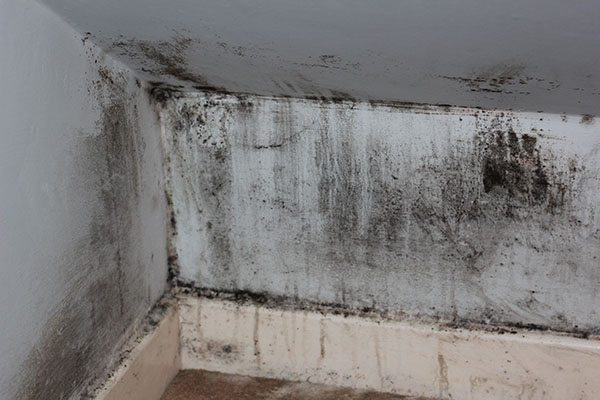Mold Exposure Sets Stage for Severe Flu
Mouse Study Suggests Common Fungus Could Worsen Respiratory Infections

New IRP research suggests that exposure to a common variety of mold could exacerbate the symptoms of respiratory viruses like the flu.
Throughout the COVID-19 pandemic, both scientists and the media have focused on the factors that influence who experiences mild symptoms or none at all and who faces potentially life-threatening consequences from the disease. Other respiratory viruses like the flu also have widely varying effects on different patients. New IRP research has found that exposure to a common variety of mold primes the immune system to overreact to the flu virus, dramatically increasing the illness’s severity.1
In order to reproduce, the fungi that make up patches of mold release spores into the air, which are often inhaled by humans and other organisms. In locations with temperate climates, such as the mid-Atlantic United States, one of the most common varieties of mold is Alternaria alternata, and people who repeatedly inhale its spores can develop breathing problems over time, such as lung inflammation and asthma.
“The black mold in the basement you see on TV shows where they do home rehabs — that’s Alternaria alternata for the most part,” says IRP senior investigator Helene Rosenberg, M.D., Ph.D., the new study’s senior author. “It’s everywhere, and certain people are extremely sensitive to it.”
In a prior study, Dr. Rosenberg and her team had found that mice repeatedly exposed to Alternaria alternata had more immune cells called eosinophils in their nasal passages.2 However, even though eosinophils are known to help combat viruses, the mice exposed to the fungus were actually more susceptible to the flu. For some reason, those normally protective immune cells were unable to prevent a catastrophic reaction to the flu virus in those animals.

Dr. Helene Rosenberg
The Rosenberg lab’s new study attempted to discover why this occurred. The IRP scientists concocted solutions containing varying amounts of Alternaria alternata and, over a period of three weeks, repeatedly introduced them into the noses of mice. The scientists then exposed the animals to an amount of flu virus that normally causes a non-lethal illness. The mice exposed to low concentrations of the fungus or a solution containing none of the mold got sick but ultimately recovered, whereas many of the animals exposed to moderate or high doses of Alternaria alternata prior to flu infection died. Mice exposed to the mold but not the virus showed no signs of ill health.
The mice exposed to the mold did not have more flu virus particles in their airways than mice never exposed to it, so their increased susceptibility to the flu was not due to increased replication of the virus in their bodies. However, their lungs were much more inflamed and contained much higher levels of certain inflammatory molecules. In addition, the fungus-exposed mice had many more immune cells in their lungs, primarily due to a dramatic increase in immune cells called neutrophils. All together, the results suggest that inhaling Alternaria alternata primes the immune system to respond in a dangerously strong manner to a respiratory virus like the flu.
“Neutrophils are critical because if you don’t have them, you have absolutely no immunity at all, but if they’re excessively activated, they wind up creating problems,” Dr. Rosenberg explains. “There’s a careful balance that has to be maintained.”
The mice exposed to the mold also had fewer immune cells called alveolar macrophages in their lungs. These cells destroy bacteria, so the fungus-exposed mice had much higher amounts of bacteria in their lungs. However, getting rid of these bacteria with antibiotics did not prevent Alternaria alternata from increasing the animals’ susceptibility to the flu. The scientists also tried deactivating or removing certain fungal enzymes and molecules from the solutions they gave to the mice before flu infection, but these efforts did not improve the animals’ odds of survival either.

Image credit: Adlamk, MicrobeWiki
Lactobacillus plantarum bacteria.
The one intervention that did help the mice was repeatedly introducing a probiotic bacterium called Lactobacillus plantarum into the mice’s noses along with Alternaria alternata. Despite having equal numbers of viral particles in their airways, mice that received Lactobacillus lost less weight after flu infection and were more likely to survive than their counterparts that inhaled the mold alone, and their lungs contained lower levels of inflammatory molecules. This trick even worked when the beneficial bacteria had first been inactivated by heat.
Additional experiments will be needed to pinpoint precisely how Alternaria alternata exacerbates flu infection. Meanwhile, Dr. Rosenberg’s research highlights the need for clinical studies that examine whether the symptoms of respiratory viruses like the flu or COVID-19 are more severe in people who live in certain regions where mold is more common or who have mold in their homes or workplaces. If such a relationship exists, doctors might begin more closely monitoring or more aggressively treating patients who have been exposed to mold, and public health officials may push more strongly for the elimination of mold inside buildings.
“Standing next to mold for five minutes may not be a big issue, but if it’s in your ventilation system at home or at work, that may have more profound health implications than we previously thought,” Dr. Rosenberg says. “Mold not only looks bad, but it’s also bad for you, and ameliorating it should be a high priority.”
Subscribe to our weekly newsletter to stay up-to-date on the latest breakthroughs in the NIH Intramural Research Program.
References:
[1] Alternaria alternata Accelerates Loss of Alveolar Macrophages and Promotes Lethal Influenza A Infection. Percopo CM, Ma M, Mai E, Redes JL, Kraemer LS, Minai M, Moore IN, Druey KM, Rosenberg HF. Viruses. 2020 Aug 27;12(9):E946. doi: 10.3390/v12090946.
[2] Alternaria alternata challenge at the nasal mucosa results in eosinophilic inflammation and increased susceptibility to influenza virus infection. Ma M, Redes JL, Percopo CM, Druey KM, Rosenberg HF. Clin Exp Allergy. 2018 Jun;48(6):691-702. doi: 10.1111/cea.13123.
Related Blog Posts
This page was last updated on Tuesday, January 30, 2024
